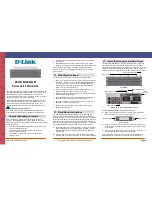
Installation Guide
23
To connect cables to SFP transceiver ports:
1.
Remove and keep the fiber port’s rubber plug. When not connected to a fiber cable, the rubber plug should
be replaced to protect the optics.
2.
Check that the fiber terminators are clean. You can clean the cable plugs by wiping them gently with a
clean tissue or cotton ball moistened with a little ethanol. Dirty fiber terminators on fiber optic cables will
impair the quality of the light transmitted through the cable and lead to degraded performance on the port.
3.
Connect one end of the cable to the SFP port on the switch and the other end to the SFP port on the other
device. Since SFP connectors are keyed, the cable can be attached in only one orientation.
4.
As a connection is made, check the Link LED on the switch to be sure that the connection is valid.
NOTE
Ensure cables are properly secured and route them away from the switch without
exceeding the minimum bending radius for fiber cables (typically a few inches). Use
cable ties to bundle cables together and secure coiled loops of excess cable. Do not
let cables hang free supporting their own weight or pull in any way that puts stress
on the connectors.














































